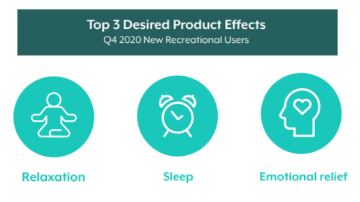Observed on April 20th, “420” is the colloquial term referencing the unofficial holiday that celebrates marijuana. According to Wikipedia, 420 began in 1971 after five high school students in San Rafael, California used the term “4:20” in connection with a plan to search for an abandoned cannabis crop, based on a treasure map made by the grower. The five students set 4:20 pm as their meeting time and the 4/20 date became synonymous with the consumption of marijuana after the popular cannabis magazine, High Times, highlighted their exploits.

In the past, 420 was a less mainstream and recognized event, but according to the Brightfield Group, 89% of cannabis users are now familiar with this holiday, and 50% of users actually celebrate on this day. Additionally, 80% of those celebrating 420 are doing so by “using more cannabis than usual.”
This mainstreaming of 420 is due in part to important changes in consumer demographics and behavior. First of all, nearly 20% of Americans are legal cannabis users (18% in 2021 vs 10% in 2020) and 62% of users report daily or multiple times a day use in 2021, up from 44% in 2019.
Looking at legal and illicit markets, an even larger percentage, 53% report they have ever used cannabis, and 35% say they are current users. This illustrates the expansion potential for the legal market. Not to mention, another 13% have never used it, but would consider trying.
Chase Terwilliger, CEO of Balanced Health Botanicals, which is one of the largest CBD companies, captures it best:
4/20 is ingrained in the cannabis culture. For us, it’s a day like any other holiday. It’s a time to sit back and take a moment to reflect on how far we’ve come as a cannabis society as well as to acknowledge the millions of people who have improved their lives with cannabis.

Why do Consumers Choose Cannabis?
New users report using cannabis for relaxation, sleep and emotional relief. These wellness benefits suggest that consumers believe cannabis offers both the recreational aspects of alcohol plus health solutions. As per New Frontier Data:
Not only are consumers choosing cannabis as part of their health and wellness routines, “growing social acceptance -- and increasing availability and diversity in the infused beverage category – will continue to drive replacement of alcohol among some cannabis consumers”.
Cannabis consumer demand now exceeds spending on spirits, according to New Frontier Data. In fact, cannabis use among college students reached an all-time high in 2020, while alcohol consumption is at its lowest point ever. Alcohol consumers have therefore dropped in “lifetime value” for alcohol companies, while cannabis consumers are top priority. This explains the growing presence of alcohol companies in the cannabis space.
Support for Legalization is Very Broad ... and Cannabis Availability is Very High
92% of Americans support medicinal use cannabis legalization, 60% support it for recreational use. 80% of Americans live in a state with some form of legalized marijuana (medical and or recreational).
According to MJBiz, legal sales of marijuana are expected to top $33 billion by the end of 2022, which is a 32% increase compared to 2021. By 2026, annual sales could exceed $52million. When including illicit sales, the total is $97 billion (2021).
In fact, cannabis is now the #5 US crop, larger than cotton, rice and peanuts.
Right here in our home state of Massachusetts, marijuana tax revenue exceeds that of alcohol for the firsttime. In December 2021, Massachusetts collected $51 million in alcohol excise taxes and $74 million in marijuana excise taxes.
Massachusetts was in the earlier wave of state legalization, so this development demonstrates the very large market potential for legal cannabis and the significant incremental revenue state and local governments can earn. States considering legalization should look to Massachusetts as an example of how cannabis can drive economic and tax revenue benefits.

420 Celebrations Around the U.S. are Plentiful
Cannabis celebrations are planned across many states. Celebrations will include art, live music, local food and, of course, a little BYOB cannabis. Some events are referred to as “Cannabis Conventions.” Colorado, one of the first two states to legalize recreational cannabis, will even host the self-proclaimed largest 420 festival in the world in Denver, the Mile High City.
Stay on the forefront of Health & Wellness Innovation
The migration of cannabis from stoner culture to mainstream health and wellness is well underway. Broad legal cannabis availability is part of a trend embracing new sources to deliver against consumer health and wellness needs. Brands across many sectors have seen cannabis impact their current sales and their innovation efforts. If you're interested in better understanding the new marijuana consumer or how to prepare your brand to compete in this new environment, then let's talk.
At Compass Marketing Boston, we are a strategic marketing agency for self care brands like yours to help navigate the rapidly evolving market and provide actionable opportunities to grow and innovate for long-term success. Connect with us to discuss strategies to grow your cannabis brand.

Xander is a seasoned General Manager and strategy leader with over 20 years experience driving profitable growth in both large CPGs and startups, including Del Monte and Akorn Technology. He focuses on businesses that deliver nutrition, health and wellness through fresh produce, plant-based foods, and botanical supplements.
See All Works